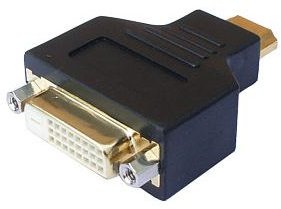How to Use a DVI to HDMI Adapter
Acronym Soup
Digital Video Interface, or DVI, is a common video interface format most often used to carry video information from modern PCs to modern computer monitors. It has replaced the VGA format, which was an older analog method. High Definition Multimedia Interface, or HDMI, has become the new standard for carrying video and audio information between devices like HDTVs, receivers, HD movie players, and game consoles.
An increasingly large number of computers are also including an HDMI output, but many older PCs and many PC video cards only offer DVI. Thankfully, DVI and HDMI are partially compatible, and getting the two to place nice together is extremely simple.
Video: The Easy Part
The easy part of getting DVI and HDMI to play nice is to use a DVI to HDMI adapter. These adapters are extremely common and extremely inexpensive. The only potential hiccup to worry about is the type of DVI which is coming from the device with the DVI output. Most will use DVI-I Single Link, but some other formats do exist and may dictate the kind of adapter is needed, so take a quick look at the different DVI formats to make sure the right adapter is purchased.
Once the adapter is in hand, using it is simply a matter of attaching the DVI output to one end and the HDMI cable to the other. That’s it! The video being sent through the DVI output should display on the device with the HDMI input without issue.
Audio: The Harder Part
While video easily converts from DVI to HDMI, audio does not. This is because DVI was not designed as a multimedia interface and so was never designed with audio data in mind. As a result, those who are using the rare older HD media players which existed before HDMI became the standard will be provided some other means of transferring audio by the player to the device with the HDMI input. This is often a component connection but could be in some other format. In any case, the audio connection provided by the player will be the only way to output audio. The DVI connection on such a device is not set up to output any form of audio data.
However, those users who are using a DVI to HDMI adapter because they are running a DVI output from a computer to an HDTV will be happy to know that there is the possibility for audio to be transferred over DVI if the PC supports it. Both Nvidia and ATI, the major designers of discrete graphics solutions, now provide methods for allowing a video card to transfer audio and video data via a DVI to HDMI adapter. A detailed account of how to make this work is provided in a separate Brighthub article.
